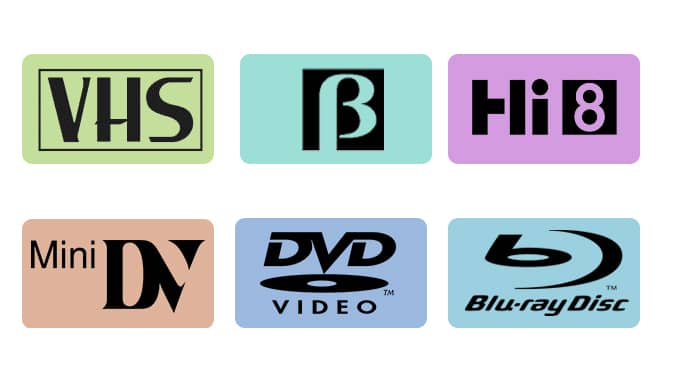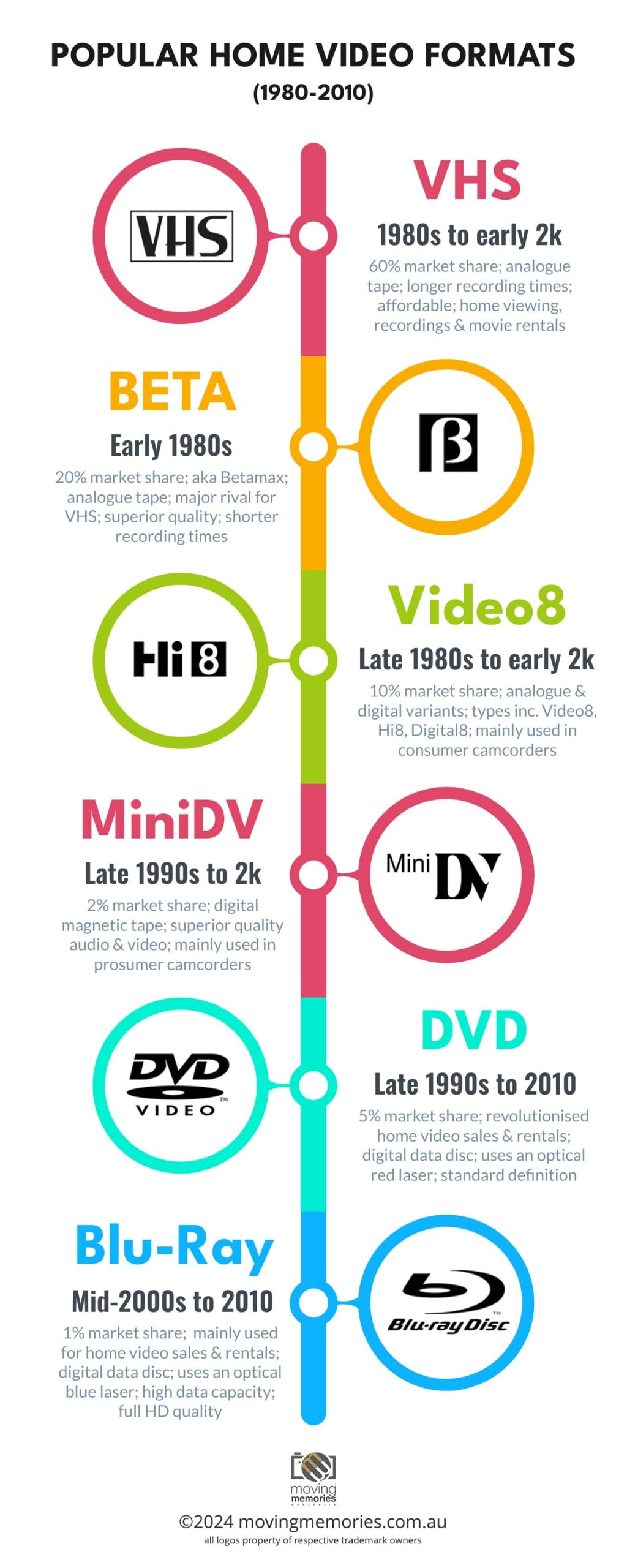Popular Home Video Formats 1980-2010
Since the advent of video recording, we have seen many multinational brands competing in the video format wars. And this competition has developed many advantages for home video users all around the world. It was VHS, developed by JVC in the early 1970s, that introduced home video recordings to the masses. In the 1980s, it was hard to imagine many homes in the developed world that didn’t have at least one VHS machine.
Despite its popularity, VHS didn’t remain the most popular format after the 1980s. We saw other popular home video formats emerge that offered more features and better quality. These included MiniDV, DVD and Blu-Ray.
The infographic above shows a comprehensive list of the most popular home video formats in Australia from 1980 to 2010.
But time has moved on quite a lot since 2010 and more formats emerged offering more convenience and video quality never seen previously. The introduction of online streaming services and cloud based video applications, like YouTube, gave home video users the ability to save and share videos almost instantly to and from just about anywhere in the world.
We’ve seen many different home video formats between 1980 and 2010 and we’ve listed the 6 most popular video formats here. Yes there are more but our list of 6 video formats were by far the most common.
We’ve created a simple illustration of the evolution of home video formats in a timeline based infographic for you to see below.
You may wonder why we’ve created an article about this information? And why focus on 6 formats between 1980 to 2010? That’s because we’ve found a lot of Australian homes have these video formats still lying around the home. Maybe not on display in a book shelf, but hidden away somewhere. And some of these home video formats still hold some irreplaceable family videos. Pretty soon, if not already, it will become very difficult to find reliable machines that will play these home videos formats.
Here’s some more detailed information on the most popular home video formats in Australia from 1980 to 2010. We include a brief description, percentage of use, and the years of use for each format:
VHS (Video Home System)
Summary: 60% market share; analogue tape; longer recording times; affordable; home viewing, recordings & movie rentals
Percentage of Use: 60%
Years of Use: 1980s to early 2000s
Description: Dominated the home video market due to its longer recording times and affordability, making it the preferred choice for home viewing and rental. VHS is an analogue magnetic tape and could typically record up to 3 hours of video and audio. It came in a few variations like VHS-C, SVHS.
Betamax
Summary: 20% market share; aka Betamax; analogue tape; major rival for VHS; superior quality; shorter recording times
Percentage of Use: 20%
Years of Use: Early 1980s
Description: Known for superior video quality compared to VHS, but it ultimately lost the format war, leading to a decline in home usage. Also known as Beta, this analogue format was the major rival for VHS but never dominated the home video market.
Video8/Hi8
Summary: 10% market share; analogue & digital variants; types inc. Video8, Hi8, Digital8; mainly used in consumer camcorders
Percentage of Use: 10%
Years of Use: Late 1980s to early 2000s
Description: Popular for home camcorders, offering better portability and quality than earlier formats, particularly for family videos. Early variations of Video8 were analogue video tapes. Popular for home camcorders, Video8 evolved to an improved format using the same tape known as Hi8. The more recent successor was Digital8 offering superior digital video and audio recording.
MiniDV
Summary: 2% market share; digital magnetic tape; superior quality audio & video; mainly used in prosumer camcorders
Percentage of Use: 2%
Years of Use: Late 1990s to 2000s
Description: Favoured for digital camcorders, providing high-quality digital video recording for home users, particularly for amateur filmmakers and family events. MiniDV magnetic tapes are digital and no bigger than a match box. Arguably offering superior quality recordings to all its predecessors.
DVD (Digital Versatile Disc)
Summary: 5% market share; revolutionised home video sales & rentals; digital data disc; uses an optical red laser; standard definition
Percentage of Use: 5% (gaining popularity towards the late 1990s and early 2000s)
Years of Use: Late 1990s to 2010
Description: Revolutionised home viewing with digital video quality, interactive features, and the ability to store more content than VHS tapes. Discs were used as the medium for DVD. It used a red laser to read or record data to and from the disc.
Blu-Ray
Summary: 1% market share; mainly used for home video sales & rentals; digital data disc; uses an optical blue laser; high data capacity; full HD quality
Percentage of Use: 1% (gaining popularity towards the late 2000s)
Years of Use: Mid-2000s to 2010
Description: Offered high-definition video quality and large storage capacity, becoming popular for movie enthusiasts and collectors, especially after the decline of DVDs. Blu-Ray utilised a blue laser packing about 5 times the amount of data than a DVD disc of the same size. It offered full high definition resolution of up to 1920 x 1080 pixels. Although Blu-Ray was a superior format to DVD, it was a far less popular format due mainly to the ever increasing use of live stream media from around 2005.
This list highlights the evolution of home video formats in Australia over the specified period, showcasing the transition from analog to digital technologies.
Digging a Little Bit Further into All the Specs
We’ve listed the most popular home video formats of the past. And compared them to modern 4k and 8k resolutions found in televisions and electronic devices available today.
VHS:
240p resolution (approximately 320×240 pixels)
Betamax:
240p resolution (similar to VHS, around 320×240 pixels)
Video8:
240p resolution (also around 320×240 pixels)
MiniDV:
480p resolution (approximately 720×480 pixels)
DVD:
576p resolution (standard definition, around 720×576 pixels)
Blu-Ray:
1080p resolution (Full HD, approximately 1920×1080 pixels)
4K Resolution:
2160p resolution (Ultra HD, approximately 3840×2160 pixels)
8K Resolution:
4320p resolution (Full Ultra HD, approximately 7680×4320 pixels)
These specs translate into the table and the diagram below. You can easily see from this information just how fewer pixels are rendered in a VHS frame compared to 8k, and everything in between.
| Video Format | Res | Aspect Ratio | Pixels (MP) | Notes |
|---|---|---|---|---|
| VHS | approx 320x240 | 4:3 | 76,800 (0.08) | Low Res, prone to noise and distortion. |
| Betamax | approx 320x240 | 4:3 | 76,800 (0.08) | Higher quality than VHS, but less popular. |
| Video8 | approx 320x240 | 4:3 | 76,800 (0.08) | Compact and portable, often used for camcorders. |
| MiniDV | approx 720x576 | 16:9 | 414,720 (0.41) | Higher Res and better quality than earlier formats. |
| DVD | Up to 720x576 (PAL) | 16:9 | 414,720 (0.41) | Widely used for home video storage and playback. |
| Blu-ray | Up to 1920x1080 (PAL) | 16:9 | 2,073,600 (2) | Higher Res than DVD, often used for HD content. |
| 4K | 3840x2160 | 16:9 | 8,294,400 (8) | Significantly higher Res than previous formats. |
| 8K | 7680x4320 | 16:9 | 33,177,600 (33) | Extremely high Res, offering exceptional detail and clarity. |
In summary, the development of home video formats has been one of the most interesting aspects to explore as a technological growth process, to convert VCR video to digital, starting from VHS and betamax to the 4k and beyond. Every format describes a different era of video recording and or viewing that makes it easier for families to preserve and replay memorable moments. Because such technologies will keep on improving, converting these older formats preserves the moments captured on video, creating a more enduring and shareable format to the future generations.
When it comes to your old family video, choosing to convert video to digital is now more crucial than ever before. It’s very convenient to do and it provides the assurance, where all of the valuable memories and special times with people from your past are preserved.


